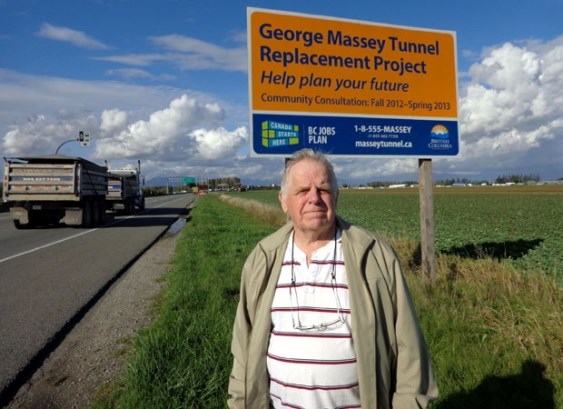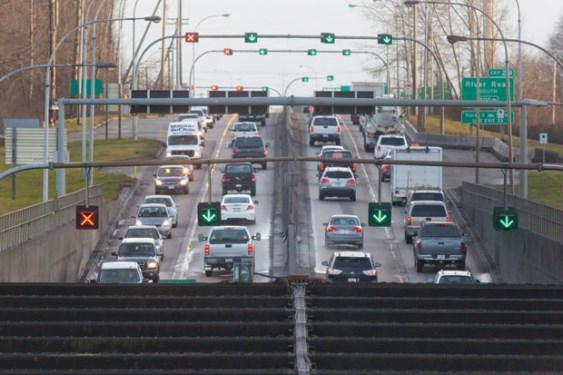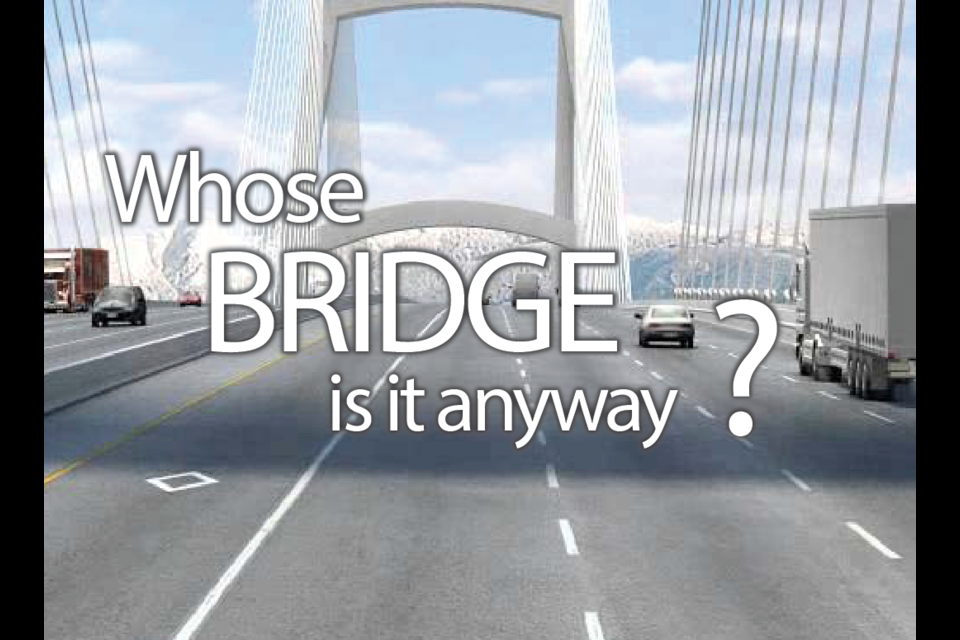A bridge to replace the aging George Massey Tunnel is scheduled to open in 2022, but is the 10-lane $3.5-billion structure being built to move traffic and goods across the Fraser River or along it?
That’s a question that’s gaining traction these days as critics of the bridge plan, and the subsequent removal of the tunnel, are wondering whether the provincial project has more to do with ships than cars and whether it ignores broader concerns about the environment.
“The provincial motivation for the bridge is clear,” says Doug Massey, whose late father, MLA George Massey, was the driving force behind the tunnel’s construction in 1959.
“Where is the motivation for Richmond and Delta to support this costly edifice to move deep draft container traffic?”
The biggest bridge project in B.C. history is scheduled to begin next year.

Massey says lobbying from industry, with little or no input from the public, Metro Vancouver or TransLink, led Victoria toward a bridge to improve access to industrial properties on the lower Fraser River.
He is also upset about plans to demolish the tunnel — which the province says can no longer handle traffic volumes and doesn’t meet seismic standards — once the bridge is built.
“The tunnel would only be an impediment if and when Port Metro Vancouver and their associates are given permission to dredge the lower Fraser River deeper, to 14.5 metres,” says Massey, who has been gathering documentation to support his argument.
He notes that as late as 2006 the province’s long-range transit plan included tunnel expansion to six lanes.
The Burns Bog Conservation Society is also raising questions, creating a website that notes instead of replacing a tunnel with a bridge, the government of the Netherlands is seismically upgrading a similar tunnel at a cost of about $420 million.
“Is a new bridge over the Fraser River the best place to spend our limited public infrastructure dollars? Can we upgrade the Massey Tunnel instead and spend the money saved on other projects, like public transit?” the society asks.
It also contends that, because the port is going to benefit if the project goes ahead, then it should “pay for a big portion” of it.
The environmental group Voters Taking Action on Climate Change has been echoing those concerns, last year making public documents it obtained that suggest the port asked the government for a bridge several metres higher than what has been proposed, to accommodate taller transport ships at a proposed terminal in Delta.
Both groups are concerned about the bridge facilitating urban sprawl and the river’s industrialization.
Port Metro Vancouver president and CEO Robin Silvester said the port was among those consulted about the potential bridge design, but added the constraints of the river, including depth and turning radius, limit the size of ships that can ply the waterway.
“We would like to be able to fully load the size of ships that we can get up the river, which is the current Panamax ships, but the idea that they’re going to be super tankers or mega ships going up the river is just rubbish. It’s completely misplaced because you couldn’t turn them around.
“When the province asked us about how big the bridge should be, what we looked at was what’s the largest air draft – the distance above the water – that a ship going up the river could foreseeably need. Two types of ships we look at there: One was a cruise ship, because we can see in the long term maybe having a cruise ship terminal on the river. The other was an LNG ship... they have the highest height above the water.”
But does that mean dredging? Not according to port chief financial officer Allan Baydala, who, in an open letter on the port’s website, says that while
the removal of the tunnel may create greater depth at that point in the river, the amount of dredging required on either side could be extensive and potentially cost prohibitive.
The port spends $15 million annually to dredge the river to its current depth of about 11.5 metres, recouping a big chunk of that by selling the sand. In 2014, Fraser Surrey Docks and the Surrey Board of Trade went to Ottawa to pitch for more dredging funds to deepen the river to 13.5 metres.
George Massey Tunnel Replacement Project director Geoff Freer told the Richmond News there’s no plan to dredge the river deeper, noting it would be a huge, costly undertaking because the entire river would need to be dredged. As far as the tunnel being removed to allow bigger ships, Freer notes the tunnel has settled and is under the river floor, so it’s not sticking up and ships wouldn’t be scraping it anyway.
Having a new bridge the same height as the Alex Fraser Bridge will also dictate what can be accommodated ship-wise, says Freer.

A new tunnel would have to be built further upriver or downstream, which would mean the loss of farmland, he added. It would have also required a deeper path under the river to meet seismic standards.
The Ministry of Transportation and Infrastructure hasn’t denied the movement of goods by water was taken into consideration when deciding on a crossing, stating in its Project Definition Report that a number of industries — including container import/export, auto import/export and breakbulk exports — use the Fraser River as a marine highway.
Consistent with Port Metro Vancouver’s Land Use Plan, with the tunnel’s removal, more intensive use of sites on the south arm of the Fraser River can be anticipated to support continued growth in Canada’s trade, the Project Definition Report notes.
A summary of the 2012 public consultation process also indicates the port and business community preferred tunnel removal as there were discussions “of river clearances and the importance of the Fraser River for trade and commerce; the capacity and depth of the existing tunnel prevents long-term growth.”
That consultation process, states the province, gave the government a social licence for the bridge, as most respondents preferred the bridge option — one of five presented at public open houses. However, that process has been criticized for not providing details of each option, and none of the options made public included a cost analysis.
Freer now says a new bridge and a new tunnel would have had roughly the same price tag, but a tunnel would have had higher seismic risks and environmental consequences. Keeping it for local traffic or rapid transit use would require significant rehabilitation and ongoing operating costs, and the tunnel would still not meet current seismic standards. However, the report doesn’t explain how a decommissioned tunnel is a disturbance to the environment.
This week, Metro Vancouver asked the province for more time to assess the project before giving it its approval (which is not required by the province). The regional government wants to assess how the bridge fits with regional transportation planning, as well as future land use south of the Fraser.
Environmental concerns also a factor to consider
On the topic of the environment, Minister of Transportation ToddStone was also asked by the News how a 10-lane bridge aligns with the province’s climate change goals, considering the report states: “The new bridge will meet current and forecast travel demand with no significant congestion to at least 2045.”
However, Stone replied: “We don’t believe, based on the projections we have, that the bridge will be congested in 30 years. The reason we’re moving forward with a 10-lane bridge is because we want to ensure the capacity is there, not just on day one of opening, but also in the decades ahead.”
He said the bridge was "green" as it will reduce idling.
But Mayor Malcolm Brodie has repeatedly raised concerns about the bridge simply moving northbound congestion from Delta to Richmond, during the morning rush hour.
According to the province’s 2006 Gateway Program Definition Report: “To capture significant benefits, twinning the tunnel would also require improvements to other crossings over the North Arm of the Fraser River, such as the Oak Street and Knight Street bridges, or a new crossing”
Stone was asked what his ministry intends to do about the north arm crossings.
He said the ministry was “in discussions” with the City of Vancouver to improve connections, but made no indication more lanes will be added.
Stone said the ministry doesn’t expect any “big spikes” in traffic congestion along the Oak corridor granted a ministry traffic analysis showed 60 per cent of traffic through the tunnel leads into Richmond.
Professional planner Eric Doherty, of Ecopath Planning, says the bridge will induce demand to drive cars in the region.
“The only way to create region-wide mobility is to build public transit,” says Doherty.
The ministry has stated adding more buses would not fix the tunnel congestion.



